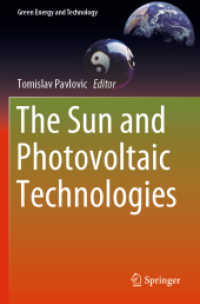- ホーム
- > 洋書
- > 英文書
- > Science / Mathematics
基本説明
Provides a serious introduction to the subject of mass spectrometry, providing the reader with the tools and information to be well prepared to perform such demanding work in a real-life laboratory. This essential tool bridges several subjects and many disciplines including pharmaceutical, environmental and biomedical analysis that are utilizing mass spectrometry.
Full Description
This book provides a serious introduction to the subject of mass spectrometry, providing the reader with the tools and information to be well prepared to perform such demanding work in a real-life laboratory. This essential tool bridges several subjects and many disciplines including pharmaceutical, environmental and biomedical analysis that are utilizing mass spectrometry:
Covers all aspects of the use of mass spectrometry for quantitation purposes
Written in textbook style to facilitate understanding of this topic
Presents fundamentals and real-world examples in a 'learning-though-doing' style
Contents
Preface. Acknowledgements.
1 Measurement, Dimensions and Units.
1.1 Introduction.
1.2 The International System of Units (SI).
1.3 'Mass-to-Charge Ratio' in Mass Spectrometry.
1.4 Achievable Precision in Measurement of SI Base Quantities.
1.5 Molecular Mass Limit for Trace Quantitation by Mass Spectrometry.
1.6 Summary of Key Concepts.
2 Tools of the Trade I. The Classical Tools.
2.1 Introduction.
2.2 Analytical and Internal Standards: Reference Materials.
2.3 The Analytical Balance.
2.4 Measurement and Dispensing of Volume.
2.5 Preparation of Solutions for Calibration.
2.6 Introduction to Calibration Methods for Quantitative Analysis.
2.7 Summary of Key Concepts.
3 Tools of the Trade II. Theory of Chromatography.
3.1 Introduction.
3.2 General Principles of Chemical Separations.
3.3 Summary of Important Concepts.
3.4 Plate Theory of Chromatography.
3.5 Nonequilibrium Effects in Chromatography: the van Deemter Equation.
3.6 Gradient Elution.
3.7 Capillary Electrophoresis and Capillary Electrochromatography.
Appendix 3.1 Derivation of the Plate Theory Equation for Chromatographic Elution.
Appendix 3.2 Transformation of the Plate Theory Elution Equation from Poisson to Gaussian Form.
Appendix 3.3 A Brief Introduction to Snyder's Theory of Gradient Elution.
List of Symbols Used in Chapter 3.
4 Tools of the Trade III. Separation Practicalities.
4.1 Introduction.
4.2 The Analyte and the Matrix.
4.3 Extraction and Clean-Up: Sample Preparation Methods.
4.4 Chromatographic Practicalities.
4.5 Summary of Key Concepts.
Appendix 4.1 Responses of Chromatographic Detectors: Concentration vs Mass-Flux Dependence.
5 Tools of the Trade IV. Interfaces and Ion Sources for Chromatography-Mass Spectrometry.
5.1 Introduction.
5.2 Ion Sources that can Require a Discrete Interface Between Chromatograph and Source.
5.3 Ion Sources not Requiring a Discrete Interface.
5.4 Source-Analyzer Interfaces Based on Ion Mobility.
5.5 Summary of Key Concepts.
5.1 Appendix 5.1: Methods of Sample Preparation for Analysis by MALDI.
6 Tools of the Trade V. Mass Analyzers for Quantitation: Separation of Ions by m/z Values.
6.1 Introduction.
6.2 Mass Analyzer Operation Modes and Tandem Mass Spectrometry.
6.3 Motion of Ions in Electric and Magnetic Fields.
6.4 Mass Analyzers.
6.5 Activation and Dissociation of Ions.
6.6 Vacuum Systems.
6.7 Summary of Key Concepts.
Appendix 6.1 Interaction of Electric and Magnetic Fields with Charged Particles.
Appendix 6.2 Leak Detection.
Appendix 6.3 List of Symbols Used in Chapter 6.
7 Tools of the Trade VI. Ion Detection and Data Processing.
7.1 Introduction.
7.2 Faraday Cup Detectors.
7.3 Electron Multipliers.
7.4 Post-Detector Electronics.
7.5 Summary of Key Concepts.
8 Tools of the Trade VII: Statistics of Calibration, Measurement and Sampling.
8.1 Introduction.
8.2 Univariate Data: Tools and Tests for Determining Accuracy and Precision.
8.3 Bivariate Data: Tools and Tests for Regression and Correlation.
8.4 Limits of Detection and Quantitation.
8.5 Calibration and Measurement: Systematic and Random Errors.
8.6 Statistics of Sampling of Heterogeneous Matrices.
8.7 Summary of Key Concepts.
Appendix 8.1 A Brief Statistics Glossary.
Appendix 8.2 Symbols Used in Discussion of Calibration Methods.
9 Method Development and Fitness for Purpose.
9.1 Introduction.
9.2 Fitness for Purpose and Managing Uncertainty.
9.3 Issues Between Analyst and Client: Examining What's at Stake.
9.4 Formulating a Strategy.
9.5 Method Development.
9.6 Matrix Effects.
9.7 Contamination and Carryover.
9.8 Establishing the Final Method.
10 Method Validation and Sample Analysis in a Controlled Laboratory Environment.
10.1 Introduction.
10.2 Method Validation.
10.3 Conduct of the Validaton.
10.4 Examples of Methods and Validations Fit for Purpose.
10.5 Validated Sample Analysis.
10.6 Documentation.
10.7 Traceability.
11 Examples from the Literature.
11.1 Introduction.
11.2 Food Contaminants.
11.3 Anthropogenic Pollutants in Water.
11.4 GC-MS Analyses of Persistent Environmental Pollutants.
11.5 Bioanalytical Applications.
11.6 Quantitative Proteomics.
11.7 Analysis of Endogenous Analytes.
Epilog.
References.
Index.








